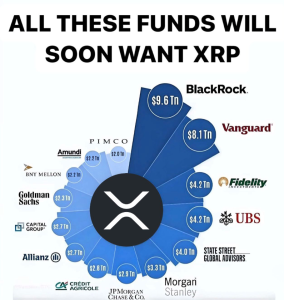Edo Farina, the CEO of Alpha Lion Academy, in a weekend post once again sparked intense conversations within the cryptocurrency world with a thought-provoking tweet. His post featured a striking visual that hinted at the possibility of major global financial institutions gravitating toward XRP as a key asset in their operations.
Alongside the image, Farina included the statement, “Don’t give your $XRP away for free,” which ignited a spectrum of reactions. While many supporters hailed the message as a bold affirmation of XRP’s potential, others expressed skepticism, questioning the viability of such a scenario in the current financial landscape.
Visual Representation of Financial Powerhouses
The image Farina shared highlighted some of the world’s leading financial institutions, such as BlackRock, Vanguard, Fidelity, UBS, and JPMorgan Chase, along with their massive assets under management (AUM). Together, these firms oversee trillions of dollars in assets, suggesting their potential influence in shaping the financial ecosystem.

The illustration hinted at the possibility that these institutions might incorporate XRP into their operations in the near future. This could include utilizing the digital asset for settlement solutions or other applications within their financial frameworks. The bold claim attracted significant attention, capturing the interest of XRP advocates while inviting skepticism from critics.
Optimism Versus Skepticism
Farina’s assertion has further energized the XRP community, where many view this as a testament to the digital currency’s untapped potential in revolutionizing finance. They see XRP as a key contender capable of bridging inefficiencies in the financial sector, offering faster, more cost-effective solutions.
However, skeptics were quick to challenge the claim. Critics demanded tangible evidence and well-defined use cases to substantiate the idea that such influential institutions would pivot toward XRP. They argued that without clear strategic plans, these assertions remain speculative at best.
Community Perspectives: A Divided Narrative
Responses to the tweet revealed a sharp division within both the crypto and financial sectors. Detractors questioned the feasibility of XRP’s adoption by these institutions, arguing that established systems like SWIFT and emerging technologies such as Chainlink’s Cross-Chain Interoperability Protocol (CCIP) may already address similar needs. They emphasized that there is currently limited public proof supporting XRP’s integration into major financial systems.
Conversely, XRP proponents championed the asset’s benefits, pointing out its ability to provide quicker and cheaper transactions than conventional mechanisms. They warned that financial firms resistant to adopting innovative solutions like XRP could face obsolescence in an increasingly competitive market.
Advocating for Diversified Blockchain Strategies
A segment of the community adopted a more cautious stance, advocating for a balanced approach to blockchain adoption. While they acknowledged XRP’s potential, they also highlighted the rapid progress of other blockchain technologies. This perspective underscored the importance of diversifying strategies to adapt to the fast-evolving financial technology landscape.
The Broader Implications
While some enthusiasts remain optimistic about the prospect of major financial institutions embracing XRP for liquidity management, settlements, or other purposes, others argue that the absence of transparent plans and actionable evidence from these firms weakens the case.
This debate underscores the broader uncertainty surrounding blockchain integration into global finance. It also highlights the need for clarity and practical applications to bridge the gap between speculation and implementation. Ultimately, the discussions surrounding XRP reflect the ongoing exploration of blockchain’s role in reshaping financial operations on a global scale.
Disclaimer: This content is meant to inform and should not be considered financial advice. The views expressed in this article may include the author’s personal opinions and do not represent Daily Addaa’s opinion. Readers are urged to do in-depth research before making any investment decisions. Any action taken by the reader is strictly at their own risk. Daily Addaa is not responsible for any financial losses.
